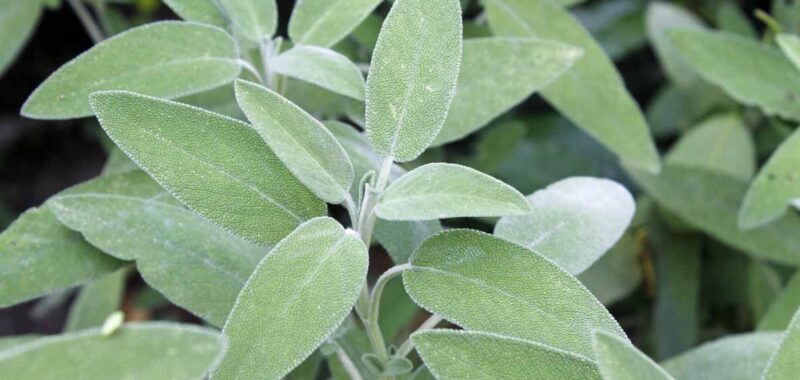Salvia officinalis
Common, culinary, broadleaf, or golden sage, Salvia officinalis, is a Mediterranean herb in the mint family that is grown as a perennial in USDA Hardiness Zones 4 to 8.
This shrubby perennial has aromatic, grayish-green leaves and spikes of two-lipped lavender flowers.
It’s used fresh or dried by cooks and herbalists around the world, and its flavor is described as astringent, and sweet/bitter.
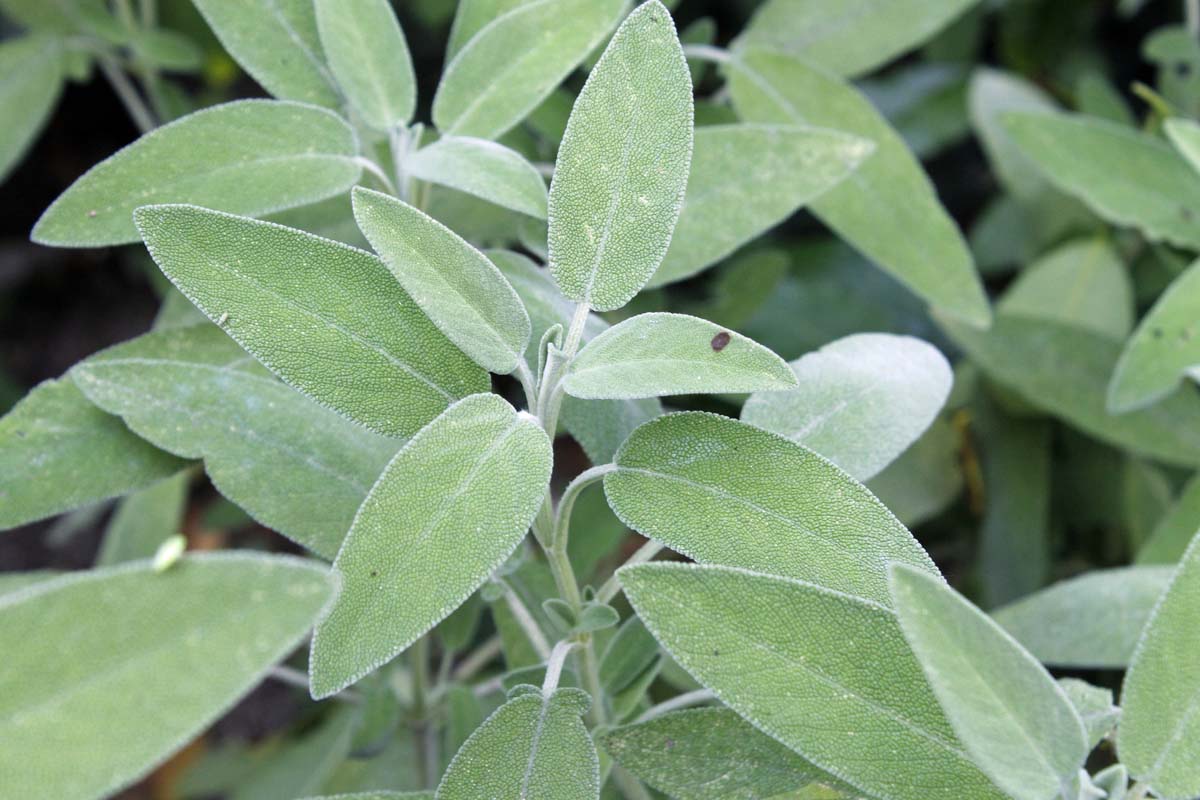

We link to vendors to help you find relevant products. If you buy from one of our links, we may earn a commission.
In this article, I’ll cover all you need to know to cultivate common sage in your garden.
S. officinalis is grown as an herb, ground cover, and ornamental.
The genus name, Salvia comes from the Latin “to save,” and “officinalis” is derived from the Latin word officia, which refers to the plant’s standing as a healing herb.
Quick Look
Common name(s): Common or Culinary Sage
Plant type: Perennial herb
Hardiness (USDA Zone): 4-8
Native to: Mediterranean
Season: Spring-fall
Exposure: Full sun
Soil type: Average, well draining
Soil pH: 5.6-7.8, acidic to alkaline
Time to maturity: 75 days
Spacing: 12-36 inches
Planting depth: 1/8 inch (seeds)
Mature size: 1-3 feet wide x 1-3 feet high
Water Needs: Low to moderate
Taxonomy
Order: Lamiales
Family: Lamiaceae
Genus: Salvia
Species: officinalis
Cultivars: Standard species. Aurea, Berggarten, Icterina, Purpurascens, Tricolor
Its use dates at least as far back as the Middle Ages, when it was prized by religious practitioners, herbalists, and cooks for its holy, healing, and nourishing properties.
From its origins in the Mediterranean region, it has naturalized around the world.
Today in the United States, its aromatic leaves are best known as a staple ingredient in holiday turkey stuffing, dressing, or filling, depending on where you come from.
And while the leaves appeal to people, the nectar-rich blossoms attract beneficial insects, like bees and butterflies, by the dozen.


They are good for the garden because they prey on insect pests and promote pollination.
Plants thrive in full sun with average soil that drains well. They tolerate pH levels ranging from 5.6 to 7.8.


They have a clumping growth habit, with mature dimensions of between 12 and 36 inches tall and wide.
For those outside Zones 4 to 8, this plant can be grown as an annual.
In addition, it makes an excellent container plant both outdoors and indoors.
Common sage is not the only edible Salvia species. Other types include bee or white sage (S. apiana), chia (S. columbariae), and pineapple sage (S. elegans).


There are also numerous non-edible, ornamental types of sage including blue (S. azurea), purple (S. dorrii), scarlet (S. splendens), and woodland (S. nemerosa).
To avoid confusion, it is essential to read your seed packets and plant labels thoroughly so you know exactly what kind you’re buying!
How to Grow
Growing S. officinalis is easy as long as you follow a few key bits of advice and is great starter plant for beginners.
Light
Find a location in full sun. Part shade is tolerated, but plants are likely to become leggy and not bloom as abundantly with less sunshine.
Soil
Work the soil to a crumbly consistency to a depth of 10 to 12 inches. If it is compacted, you may add some compost or builder’s sand to loosen it.
Excellent drainage is essential, as plants that stand in water are likely to suffer root rot.


Some folks like to mound the soil up, as you would to grow squash, to promote water run-off.
Transplanting
To transplant seedlings, cuttings, divisions, or nursery starts to the garden, acclimate them gradually to the outdoors if temperatures are still falling below 50°F.
Set them in a sheltered area outside to “harden off” for a few hours each day, over the course of four or five days.
Increase the time a little each day, and transplant when temperatures are sufficiently warm.
Place transplants into the prepared bed at the same depth they were growing in their containers.
Water
Keep the soil moist, but don’t overwater.
Once established, water when the soil is dry and never over-water. This plant exhibits above average drought tolerance.
Container Growing
Sage has shallow roots that make it well-suited to container gardening.


Choose pots that can accommodate the mature width of the variety you have chosen. Remember that containers tend to dry out before ground soil, so you may need to water more often.
Companion Planting
While it is an easy plant to grow, S. officinalis gets along well with some plants, and not with others, as its intense aroma can impact their flavor.
Good companions are carrots, cole crops like broccoli and cauliflower, strawberries, tomatoes, and rosemary.


Place it well away from alliums like onion and garlic, cucumbers, and fennel.
Some gardeners grow sage as an ornamental, using it as border edging, or a front to mid-bed placement.
In cool regions where it grows as an annual, it will die to the ground each year, giving you a chance to switch up your planting scheme.
In warm locales where it is an evergreen perennial, it tends to become woody. Each spring, prune off the old growth when the new shoots start to appear.
Cultivars to Select
Botanical species S. officinalis and cultivated varieties are readily available to the home gardener.
As described, the true species of common sage, as found in the wild, has gray-green leaves and lavender-blue flowers.
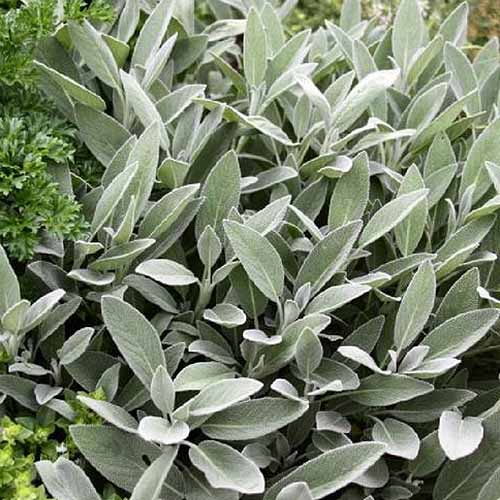

S. officinalis – Common Sage
Plants reach mature heights of 18 to 24 inches.
Find S. officinalis seeds in a variety of packet sizes available from Eden Brothers.
Cultivars offer a number of options with purple, yellow, and variegated leaves, as well as white, pink, or lavender-blue blossoms.
Aurea
S. officinalis ‘Aurea’ is a golden sage with green and yellow leaves, lavender-blue flowers.


This variety grows to a mature height and width of 12 to 18 inches.
Berggarten
Noteworthy for having especially large leaves, S. officinalis ‘Berggarten’ puts most of its efforts into leaf production, and produces few blossoms.
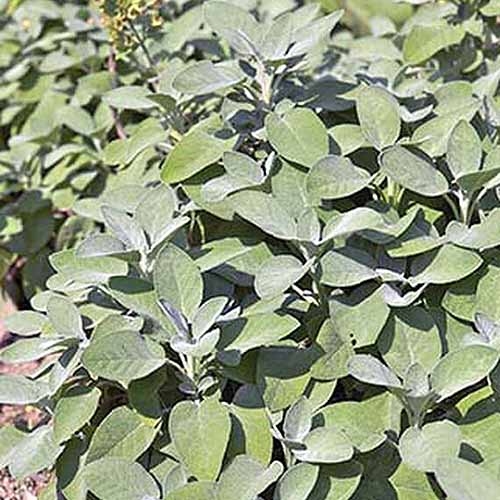

‘Berggarten’
It has lavender-blue flowers and reaches heights of 18 to 24 inches.
Find ‘Berggarten’ starter plants available from Burpee in packages of three.
Icterina
A golden sage, S. officinalis ‘Icterina’ has variegated leaves of green and yellow, and lavender-blue flowers.


Expect a mature height of 12 to 24 inches.
Purpurascens
Purple leaves and lavender-blue blossoms characterize S. officinalis ‘Purpurascens.’
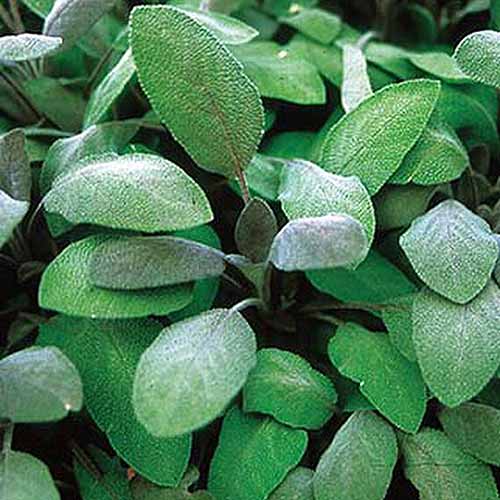

‘Purpurascens’
Mature heights range between 12 and 24 inches.
Find a set of three starter plants available from Burpee.
Tricolor
True to its name, S. officinalis ‘Tricolor’ has leaves of green, purple, and white.


The flowers are lavender-blue, and mature heights are between 12 and 18 inches.
Propagation
S. officinalis is easy to propagate from seed, stem cuttings, by division, and nursery starts.
From Seed
Start seeds indoors up to eight weeks prior to the last frost date, or sow them directly outdoors after all risk of frost has passed. Sow to a depth of 1/8-inch.
To direct sow after the danger of spring frost has passed, sprinkle seeds on moist soil and barely cover them.
Keep the soil moist, but not soggy, while they germinate.
When seedlings have two sets of true leaves, thin them to accommodate mature dimensions ranging from 12 to 36 inches, depending on the variety.
From Stem Cuttings
In the spring, cut a four- to six-inch length of stem with a growing tip. Pinch off the bottom two inches of leaves to expose a bare stem. Dip the end into food-safe powdered rooting hormone, if desired.
Place the stem in a glass of water, taking care that no leaves are below the water’s surface. Keep it in a location with indirect light and change the water daily.
When roots form, you can transplant the rooted cutting to the garden, as described below.
By Division
Divide perennial plants in early spring to make additional ones.
To do this, dig up the entire plant, and using a garden knife or shovel, cut the plant into two or more sections.
When you transplant, maintain the same depth in their new placement.
You can learn more about dividing perennials in this guide.
Pests and Disease
S. officinalis is not prone to disease or pest issues when grown under optimal conditions.


This includes:
- A location with full sun
- Sufficient watering that is neither deficient nor excessive
- Soil that drains well
- Ample airflow around plants achieved by proper spacing and weeding
When plants are underwatered or oversaturated, or have inadequate airflow, they may become vulnerable to sap-sucking pests such as aphids, mealybugs, spider mites, spittlebugs, thrips, and whiteflies.
With excess water, shady placements, and overcrowding, fungal conditions like leaf spot, powdery mildew, and rust may occur.
Damp conditions may also invite slugs that nibble roots and leaves, contributing to stem and root rot.
Treatment methods for sap-suckers include a firm spray with a hose and treatment with food-grade insecticidal soap.
Fungal infections may respond to food-grade fungicides.
There are various slug-away remedies, but once roots are rotten, plants are unlikely to recover.
Note that while it may sound like a good idea to apply a layer of mulch around plants to inhibit weed growth, this is not recommended as it can cause the soil to retain too much moisture.
Give plants every opportunity to succeed with best practices, and you are not likely to have issues. And don’t worry about deer, because the aroma doesn’t seem to appeal to them.
Harvesting
The stems, leaves, and flowers of common sage are edible.
For perennial growers in the warmest regions, they are available for harvesting year-round.


Some folks like to pinch growing tips regularly to keep plants from flowering, claiming it results in better leaf flavor.
However, you may let plants flower, especially if you want to use the dainty blossoms as a garnish.
Throughout the growing season, periodically pinch off flowers, stems, and leaves to promote new growth.
To harvest leaves, pinch them off with your thumbnail, or snips, at the base where they meet the stem.


Do the same for individual blossoms, or snip off entire flower stems just below the bottom row of blooms.
You can harvest up to half of a plant at one time during the growing season. Doing so encourages a more rounded and bushier plant, and slows the flowering and seed producing process.
In zones where the herb is a perennial, many folks retire a plant after three or four years if it becomes too woody. However, as mentioned, you can revitalize and retain optimal flavor with judicious pruning.
Preserving
Freshly harvested sage leaves will keep for three to four days in the refrigerator. Simply wrap them in a paper towel, and place in a plastic bag.
You can dry the leaves by tying stems together and hanging them in a cool, dry location. Alternatively, you can use a dehydrator or oven on a low setting.
Dried sage will keep for up to a year when stored in a sealed container in a dark pantry.


It’s convenient to have a ready supply on hand for an array of savory dishes.
You can learn more about storing herbs using drying and freezing techniques per the instructions on our sister site, Foodal.
Cooking Ideas
Do you love potatoes, but need to change things up a bit? If so, you’ll want to try these delicious sage hasselback potatoes.
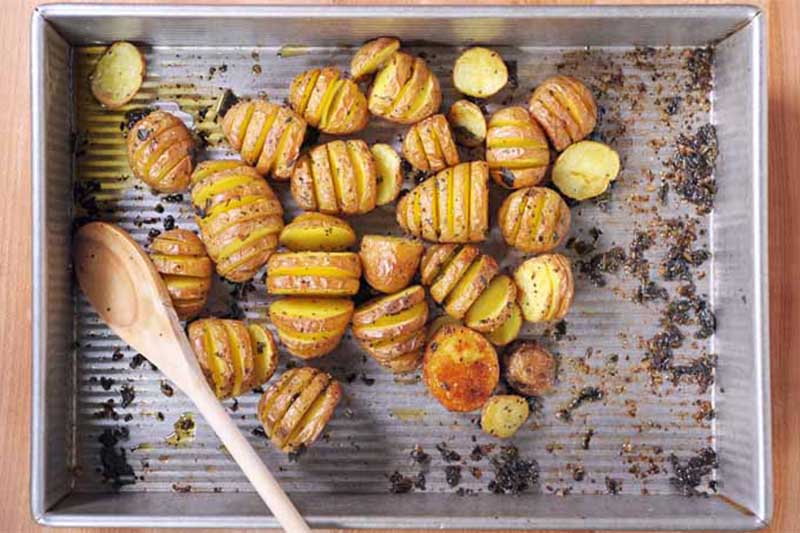

Slits are cut into the top, which allows the lovely taste of real butter, salt, and sage to work their magic in the interiors, making for crisp and soft spuds full of rich flavors.
You can find the recipe on our sister site, Foodal.
Are you tired of dried out, chewy turkey?
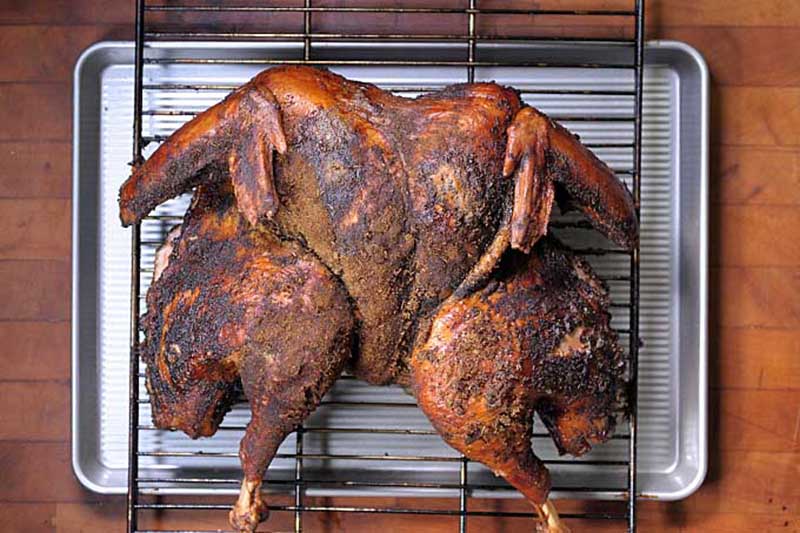

If so, take a look at this recipe that incorporates various techniques such as butterflying, dry brining, and dry rubbing to lock in flavors and juices. Check it out now, on Foodal.
Sesame sage roasted vegetables with barley is the perfect vegan main dish for fall, or a delicious holiday side dish.
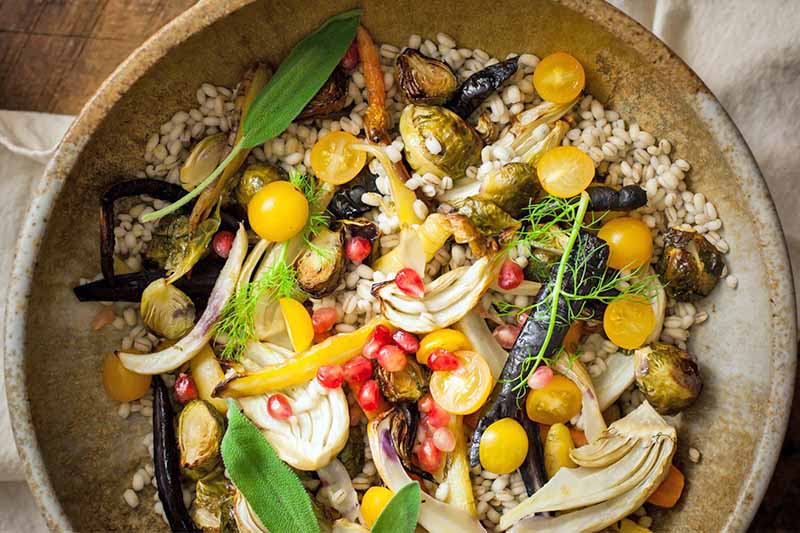

With fennel, carrots, Brussels sprouts, cherry tomatoes, and pomegranate, these grain bowls are irresistible.
And don’t forget the flavorful sesame-sage dressing! You can find the recipe also on Foodal.
To find even more delicious recipes with sage, check out all that is available on our sister site, Foodal.
Sage Rocks
You may be familiar with the renowned parsley, sage, rosemary, and thyme foursome, popularized by Simon & Garfunkel’s hit version of the classic English Folk song, “Are You Going to Scarborough Fair.”


This is a reference to the widely acclaimed herbs’ extensive folk history. Native Americans have long used sage in traditional rituals that celebrate, heal, and purify.
Common sage is a classic when it comes to herb gardening, and where it can’t survive a cold winter, it is often cultivated in containers that are brought inside until the growing season resumes.
In warmer climes, it may grow so big and bushy that its stems become woody. If so, replace your plants every few years for a steady supply of not only leaves and blossoms, but palatable stems as well.
And finally, if you’re in a temperate zone and are looking for a lawn alternative, consider sowing herbs as groundcover, where every footfall fills the air with fragrance.


Are you growing sage in your garden? Let us know in the comments below!
If you’re interested in growing more mint-family classics in your herb garden, you’ll need these guides next:

